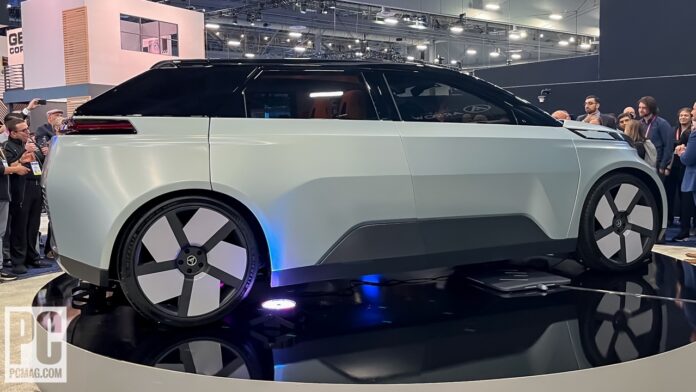LAS VEGAS—Canada debuted its first zero-emissions concept vehicle at CES in Las Vegas today as part of “Project Arrow”—the country’s first new global automotive brand in 100 years.
The Automotive Parts Manufacturers’ Association (APMA), the company behind Project Arrow, first announced the initiative at CES 2020(Opens in a new window). Then, a country-wide student competition that summer, won by the team from Carleton University in Ottawa, determined the specifications for the vehicle. The CES 2023 concept vehicle brings their designs to life in a working prototype.
Flavio Volpe at CES for Project Arrow
(Credit: Emily Dreibelbis)
“Today at CES, we reveal Project Arrow to the world, with 25 new technologies,” says Flavio Volpe, president of the APMA. “The Prime Minister dared us to imagine Canada’s net zero mobility future and the Premier of Ontario challenged us to build it.”
While the concept car is not intended to be driven by the public, it’s the first step toward Project Arrow’s goal of mass production. The final vehicle will be around $60,000 with a run rate of 50,000 units manufactured per year, Driving.ca reports(Opens in a new window), starting with the 2025 model year.
@emilydreibelbis(Opens in a new window) Introducing Project Arrow made by Canadians, for Canadians – the country’s first new homegrown car brand in 100 years and first EV. Pretty cool, eh? #CES(Opens in a new window) #electricvehicle(Opens in a new window) ♬ So Fresh, So Clean – Outkast(Opens in a new window)
The vehicles will be built with parts and components from over 50 Canadian companies in “the biggest industrial collaboration project in Canadian automotive history,” Project Arrow says. This includes the powertrain, exterior, interior construction, and battery, as well as the software behind the vehicle. Project Arrow partners include Quebec-based autonomous driving company Leddartech, as well as companies that specialize in LiDAR, “smart cockpits,” and cybersecurity.
Interior of the Project Arrow vehicle
(Credit: Emily Dreibelbis)
Several government bodies across Canada have contributed $8 million to Project Arrow, including the Governments of Canada, Quebec, and Ontario, where the vehicle was built.
“As the world transitions to a cleaner and more sustainable economy, Canada’s highly skilled workers will be key in building the green vehicles of the future,” says François-Philippe Champagne, minister of innovation, science and industry of Canada. “Project Arrow is a shining example of what Canadian talent, innovation, and know-how can accomplish.”
Recommended by Our Editors
(Credit: Emily Dreibelbis)
This domestic focus mirrors the climate in the American auto industry. To qualify for the federal tax credit in the US, electric vehicles must be assembled in the States with a certain percentage of its battery construction and components sourced domestically. Federal lawmakers have also approved billions for the domestic battery industry and a national charging network.
Other countries captializing on the EV surge include Vietnam, which is making electric cars under the VinFast brand, which shipped its first batch of vehicles to US soil last month.
While Project Arrow claims its vehicles are intended for Canadian drivers, the brand’s choice to reveal the concept car at a US trade show suggests they may eventually reach global consumers.
Get Our Best Stories!
Sign up for What’s New Now to get our top stories delivered to your inbox every morning.
This newsletter may contain advertising, deals, or affiliate links. Subscribing to a newsletter indicates your consent to our Terms of Use and Privacy Policy. You may unsubscribe from the newsletters at any time.
Hits: 0

















